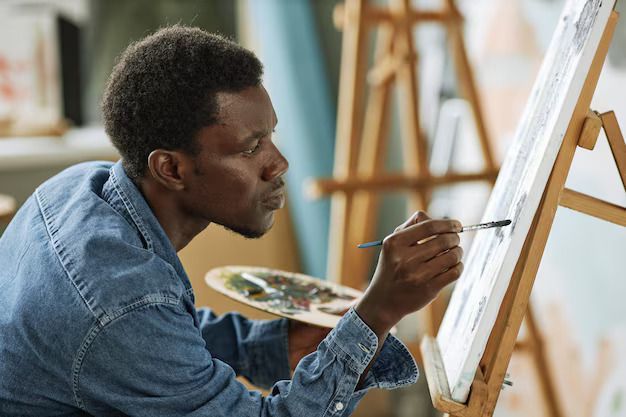
The global economy is challenging, and generating income from multiple streams is everyone’s goal. While you can make money from a side gig, few can actually help you work through your issues.
A team of researchers discovered this in a study published in the journal The Arts in Psychotherapy that making art benefits people dealing with health conditions like addictive behaviours, eating disorders, or mood disorders.
The amazing thing is that art isn’t limited to painting and drawing; photography and colouring, for instance, are also forms of art.
The price of artwork is often high, with pieces being sold for millions of dollars or naira. Artists like Renike Olusanya, Arinze Stanley, and many others have successfully made a livelihood from their craft.
You don’t need a formal education to create art
Making art is an accessible way to generate income. In today’s world of abstract art, formal training isn’t always necessary. Once you’re able to create, you’re good to go.
Platforms like YouTube and TikTok offer countless tutorials to help you learn and improve. I spoke with Ima Elijah, a journalist and PR professional, about how she learnt to make art while balancing a 9-to-5 job. She shared:
“I think I’ve definitely used a lot of YouTube resources. Aside from that, I’m probably self-taught. I don’t think I’ve ever worked with anyone or had someone teach me about painting or fine arts in school.” She adds, “There’s this burden to bring something to life.”
Your art doesn’t have to be perfect to be shared; you can still be working on it and share it. A 2016 study published in the Journal of the American Art Therapy Association found no significant difference in health outcomes between experienced and non-experienced artists, indicating that art can bring positive experiences regardless of skill level.
ALSO READ: Top 5 most expensive paintings ever soldUse your imagination and personal experiences
You might wonder, What can I even paint or create? The answer lies in your imagination and personal experiences or your observation of the world.
You don’t have to overthink it. For instance, Ima’s family faced media scrutiny and unsubstantiated accusations, so she drew planets as a form of escapism.
Think about your own experiences. What can you share with the world in the form of art? Ima’s paintings of planets were inspired by feeling let down by the world. Similarly, you can channel your emotions into your creations. Personally, I turned to art after a traumatic experience this year.
Drawing and painting brought immense relief. I remember heading to Ikeja Under Bridge to find some solace, spending hours immersed in my art.
During those moments, my pain and anxiety faded into the background. Renike, a popular visual artist featured on CNN and GQ, has shared that she started painting after a heartbreak.
Share your art on social media
Social media is a powerful tool for showcasing your artwork. Keep posting your creations, and you may develop an audience.
Videographer Niyi Fagbemi, for example, became famous after his video of the Ojude Oba festival went viral. Don't think it's not good enough; don't limit yourself.
Organise exhibitions
All you need for an art exhibition is a venue. People love to view art, and many are willing to pay for it. Ima’s second art exhibition at Monty Suites, Lekki, is underway after her successful debut last year. Once you’ve generated social media buzz for your art, you can sell it to the world.
Making time for art despite a busy schedule
If you’re wondering how to create art with a busy job schedule, it’s all about prioritization.
Ima explains: “The reason I have energy for corporate work is because I make time for art. Now I can sell my pieces, but I don’t do art for work. I do art for myself, for healing, for relaxation. The busy schedule has to pause so I can make art.”
Since we know art heals, it’s essential to make time for it—even if you don’t intend to make money from it.